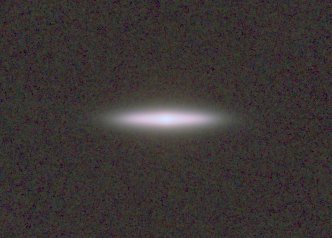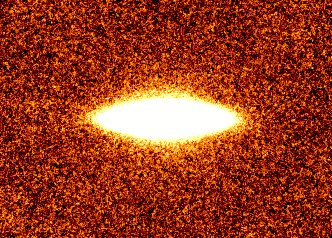The outermost stellar haloes of galaxiesBeyond their spectacular spiral arms and their bright central bulges, spiral galaxies are embedded in extremely faint stellar haloes, that can reveal tantalizing clues to how the galaxies formed. This elusive compoment has long defied astronomers' efforts to characterize it, but scientists at the Max-Planck-Institut fuer Astrophysik have recently developed new techniques which exploit the wealth of data in the Sloan Digital Sky Survey to pin down the properties of the luminous haloes around spiral galaxies with unprecedented accuracy. Their results have now been confirmed by the Hubble Ultra Deep Field data, the deepest view of the Universe ever. In the currently favoured cosmological framework galaxy formation proceeds hierarchically. Small protogalaxies form first and then merge, forming stars and accreting material until they eventually reach the status of "adult" galaxies, as seen around us in the local universe. Adult galaxies come in many different shapes, from elliptical star piles, to disc-like spiral galaxies and irregular, almost chaotic systems. As a by-product of their violent assembly, a significant fraction of the stars in a galaxy is expected to be thrown out to large distances, forming a stellar halo. Observing the properties of these halo stars can reveal when and how the galaxy was assembled and clarify the physical mechanisms that govern galaxy formation. The stellar halo around our own Galaxy, the Milky Way, has been studied since the 1950's, and progress in observational techniques over the last few years has provided a detailed and rather surprising picture of its structure. Rather than being smooth and regular many of the stars lie in streams which seem to be the remnants of disrupted dwarf companion galaxies. This structure has strongly shaped current ideas about how the Milky Way formed. But how far can we generalize such models to other galaxies than the Milky Way? Do all spiral galaxies have a stellar halo? If so, do all stellar haloes have similar properties? Due to the extreme faintness of the halo (its surface brightness, i.e. the luminosity emitted per unit area, is several hundred times fainter than in the central regions of the galaxy) observations are very difficult and are so far available only for a few nearby galaxies.
Using the wealth of data provided by the Sloan Digital Sky Survey
(
Are our results consistent with the hierarchical scenario of galaxy
formation? Careful theoretical calculations of the structure expected
will be needed to get a definitive answer. Our results include some
definite surprises. For example, the colours of the extended halo
emission are not easily explained by standard models of stellar
populations. Although this might, in principle, indicate a problem
with our stacking analysis, a recent study of an edge-on disc galaxy
in the
Stefano Zibetti, Simon D. M. White, and Annette M. N. Ferguson
Further reading: |
||||||||



